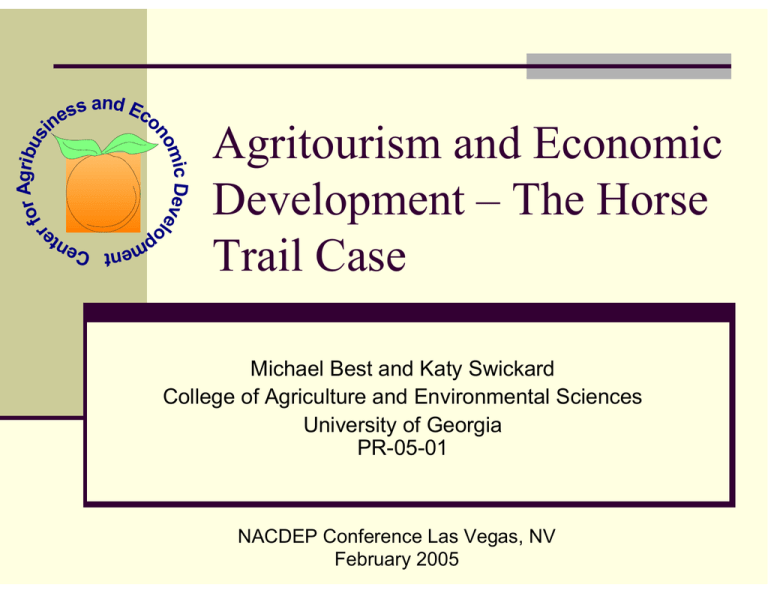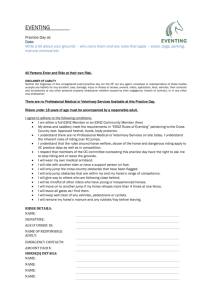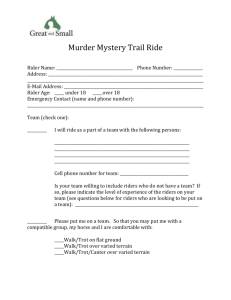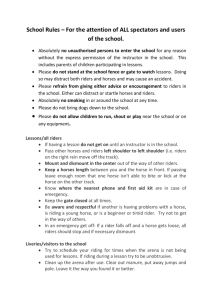Agritourism and Economic Development – The Horse Trail Case
advertisement

or Agribus f r i mic Develo no ss and Eco e n Agritourism and Economic Development – The Horse Trail Case Michael Best and Katy Swickard College of Agriculture and Environmental Sciences University of Georgia PR-05-01 NACDEP Conference Las Vegas, NV February 2005 ent Cent e pm Agritourism and Economic Development Georgian’s are looking for alternative means of generating on-farm income. One way to utilize farm resources is to allow people to employ the farm for non-traditional farming activities. Horse trails offer farmers the opportunity to generate additional on-farm income and still continue their farming activities (this type of land use today is commonly referred to as agritourism). A farmer in Quitman County Georgia owns 2,400 acres of row crop and timber land and is exploring the possibility of cutting horse trails in his timber land. The Center for Agribusiness and Economic Development in conjunction with the Quitman County Extension Service, conducted a statewide survey of horse owners to obtain information on what they are looking for in trail riding facilities Agritourism and Economic Development It is easier to sell something that people want than it is to sell something that is easy to produce. Given this fact, it is important to know what trail riders are looking for in a riding facility. It is also important to determine how often people ride, what they are paying, how long they stay and how many people are in the party to design a successful facility. The results of the statewide riders’ survey address these issues and information obtained from surveys like this one help farmers increase their income potential by providing them with information that is useful in developing their business plans and allowing for a more efficient use of their limited resources which contributes more effectively to economic development. The Survey A mail survey was sent to horse club members across Georgia. A total of 153 completed surveys were returned. The survey targeted riders who trailer their horses to visit horse trails. The margin of error was +/- 8.8% at the 95% level of confidence. Identifying the Target Market By identifying a target market, it is possible to estimate the market potential for a product or service. Generating a detailed description of potential customers. Identifying the sub-segment of the general population most likely to utilize riding trails. The more detail, the easier to estimate market potential. Target Market Results 84% of horse trail riders are female 34% are college graduates Average age is 47 98% are white Mean household income is $62,500 61% are from rural areas Market Potential 35% of trail riders are willing to travel 50 - 100 miles to ride. 23% will travel 200 miles or more. The average trail rider will travel 153 miles 41% take less than five (5) trips per year 37% take five (5) to ten (10) trips per year The average number of trips per year is eight (8) Market Potential The average trip is three (3) days and two (2) nights On average riders pay $15 per night to camp with their trailers at trail riding facilities. Facilities ranged in cost from $0 to $40/night Market Potential Fees for riders ranged from free to a high of $80 a day. The average half-day ride is $5.60 for access to trails. Full-day trail ride access is an average of $9.56. Weekend access typically costs around $14.56 per day. Market Potential More trail riding trips occur during the non- winter months. Closing the facility to riding during the winter months could free it up for hunting. Over half of trail riders in Georgia are at the intermediate skill level or above. Market Potential 38% indicated they would be very likely to visit Southwest Georgia Riding Trail 30% indicated they would be somewhat likely to visit. Informing Potential Riders Sources of information about trail riding facilities vary greatly with the majority learning about them on the internet (51%) The second greatest mention is word of mouth. (42%) Facility Amenities Water faucets close to parking (83%) Toilet facilities (74%) Camping area (65%) Shower facilities (46%) Barns/stalls (39%) Picnic area/grills (35%) Pads for trailers (27%) Pasture space for horses (25%) Facility Amenities Appearance/ scenery (80%) Offers Trails of varying difficulty (74%) The presence of wildlife (55%) The friendliness of the people that work there (51%) Historical attractions (15%) A restaurant or snack bar (13%) Other Activities Trail Riders Participate In During a Trip Hiking or walking (33%) Swimming (33%) Photography (32%) None (25%) Fishing (23%) Visiting Parks (17%) Birdwatching (15%) Visiting local museums (14%) Competitor Analysis There were 66 public and private horse trail riding operations across Georgia. 17 of these had camping facilities. Trail sizes range from one (1) mile to 8,000 acres worth. Nine (9) have horse stalls and five (5)offer boarding services. 11 operations provide rental horses. Situational Analysis Georgia Horse industry is growing rapidly. In 2001 horses ranked 8th in revenue for agricultural products. It is the fastest growing segment in Georgia’s agricultural industry. Georgia’s population has increased by approximately 2 million people over the last 10 years. Situational Analysis Population growth has fueled urban sprawl and the development of rural areas. As the horse industry in Georgia grows with more people who do not live on farms, having these places to ride horses becomes more important. Estimates show that there are over 1,000 boarding facilities in the state of Georgia. “Adding Value to Georgia’s Agricultural Economy Through Research and Extension” or Agribus f r i mic Develo no and Ec s s o ne ent Cent e pm Michael J. Best and Katy Swickard www.caed.uga.edu The University of Georgia College of Agricultural & Environmental Sciences






